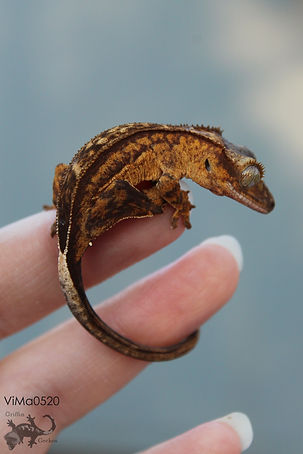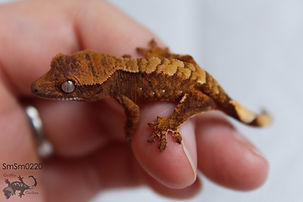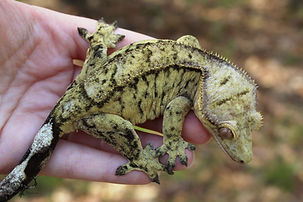
Griffin and Mundy's- Care Sheet
Welcome to our Care Sheet! Below is how we personally care for our geckos, but keep in mind there are also many other viable ways to provide care for them. This is just what we've found to work best for us! We will include along the way things we do and don't recommend. As always, feel free to contact us with any specific questions you may have!
Housing Your Gecko
An important thing to remember with Crested Geckos is that this is an arboreal species (tree dwelling). They can have a large range of setups, so long as they meet a few basic requirements. The enclosure needs a few sturdy perches, places to hide, and a good amount of foliage. It does not, however, need to be so full of plants that the gecko can't jump around. You can overcrowd it if you're not careful.
Enclosure Size: The size of the enclosure is very important. We never recommend putting a new, 5 gram gecko directly into its long term, adult enclosure. Breeders house hatchlings and young geckos in small enclosures because this is where they best thrive. Many breeders, ourselves included, have the best luck keeping small geckos (from hatching, up to approximately 10 grams) in shoebox totes, roughly 14 x 8 x 6 inches. We have personally had success using 7 quart containers. Using similar sized "Kritter Keeper" style enclosures is also a great way to house geckos needing a small enclosure, before they grow into their adult sized enclosures.
We include a plant and perch of some kind, along with their food and water bowls. Pool noodles make an affordable option for sturdy perches, but if you want a more visually pleasing perch, cork bark is your best friend! If you use pool noodles, We prefer the ones without holes in the middle, as geckos can become stuck in them if they outgrow them. There are also several options available on the market for reptile perches.
Make sure the perches used include ones that span the length of the enclosure, both vertically and horizontally. When too few places to rest the full body are available, it can promote the development of FTS (Floppy Tail Syndrome). That is a weakening in the muscles at the base of the tail, that cause the tail to flop forward when the gecko is upside down, no longer able to support its own weight. Having ample perches can help prevent this.
When a gecko hits about 10 grams, We move it up to its juvenile enclosure! We use 25 quart tubs, and add decor accordingly. Remember, a few sturdy perches and some coverage, but not filled. The gecko should be able to easily get around.
Then when a gecko hits about the 25 gram mark, we move it up into their adult enclosures. A 12 x 12 x 18 inch enclosure for the smaller adult gecko, approximately 35-50 grams, is the standard minimum. However, the 18 x 18 x 24 inch enclosures really give an adult gecko room to stretch out, especially for the adults that hit around the 60 gram mark and higher. You can also go up in size from there, as long as you have enough foliage and perches to compensate.
Air circulation is also very important! When using tubs, we find a 2 inch, round vent on each end gives us the best airflow and allows the humidity to fluctuate. Low air flow and constant high humidity will lead to health issues. We live in the south, so our climate is generally pretty humid. If you live somewhere much more arid, you may need a little less circulation, or a lighter misting.
Substrate: We have found that keeping all of our geckos on paper towels works best for us, in order to better monitor health, defecation, and for an easier cleanup. More naturalistic options are Coconut Fiber, reptile safe bark, or topsoil with no added pesticides or plant foods. There are pros and cons to every substrate and we recommend doing further research to decide the best option for your geckos. Sand or sand replacements, such as crushed walnut, aren't species appropriate and should never be used. Sand and similar substrates can cause life threatening impaction in a Crested Gecko, and make it impossible to maintain the proper humidity.
Lay Boxes: We provide all of our adult females with a lay box (sometimes referred to as a humid hide), to give them somewhere secure to lay their eggs. Remember, females can, and very likely will at some point, regularly lay infertile eggs during their adult life. We simply provide the bowl portion of a large enough tupperware container (approximately 5 inches across minimum, and several inches deep), or a wide bottomed bowl (to prevent tipping), and fill it with moistened Sphagnum moss. In order to maintain the substrate humidity, just mist it when misting your gecko. When the female lays eggs, she will often lay them at the bottom of the substrate. We prefer clear containers to make it easier to check for eggs.
Cohabitation: We personally house all of our geckos separately. Housing hatchlings, adult females, or breeding pairs together can safely be done, but there are risks with any cohabitation. We never recommend anyone try this without having long-term experience beforehand, so that you know how to identify potential issues, and minimize those risks. Incorrectly cohabitating this species can lead to tail nips, toe or limb loss, bite wounds and scarring, food guarding, weight loss, stress and in extreme cases, death. Experience with the species is needed so you know what to look for, should these issues arise. Housing your new gecko by itself avoids the risk of the above altogether.

Temperature and Humidity
Temperature: Crested Geckos are subtropical and therefore heat sensitive. Cold blooded reptiles in general rely on their surroundings to regulate their body temperature, but this species doesn't require the basking spot that more traditional reptile pets need. Crested Geckos specifically tolerate cool temperatures much better than hot ones. An overheated Crested Gecko can quickly become a deceased one. Anything above 85°F starts becoming dangerous. The temperature should never reach 90°F. They comfortably tolerate down to about 68°F, but it's not recommended to keep them at that temperature. They will survive, but not thrive, as digestion and other bodily functions require a higher temperature. Balancing safe temperatures with good growth, we keep our geckos in the 74-78°F range, with a drop at night down to 70°F. They're a very forgiving species, but they show our preferred growth rates when kept in those temperature ranges. We also don't recommend a heat lamp, unless absolutely necessary in a cold home, in which case, a low wattage bulb and a thermostat are an absolute must. The safest method to raising the temperature of a Crested Gecko habitat, especially if you have multiples, is raising the temperature of the entire room. We heat and cool our building with a heating and air window unit, and use a fan to help circulation. If you just have a single gecko though and your room stays around the 70-72°F mark, don't worry. That's still perfectly fine for this species. They may just have a slightly slower growth rate. You don't want to consistently keep them lower than that though, as it can start to affect food digestion and growth if they're too cool for a long period.
Humidity: Crested Geckos require high humidity, but just as importantly, they need a dry-out period. In our opinion, the best rotation you can use is misting heavily in the afternoon, up to about 80-90% humidity, and allowing to dry back out between misting times, down to about 50% humidity. It should be dried out within about 24-48 hours of misting. If it's entirely dry in only a couple of hours, mist more heavily. If it's still soaked after that much time has passed, then you likely need to mist a little less each time, or add more ventilation if you're using a storage tub. If it stays completely wet for days at a time though, it can lead to skin irritation, and skin and respiratory infections. Misting the correct amount once a day, or every other day, helps ensure your gecko stays hydrated. Crested Geckos drink the water droplets, so using chlorine free water is a must. We personally use our city's tap water, and add a reptile safe de-chlorinator.
*As for UVB, this species can benefit from it, but it's not required, and is much more difficult to provide when using tubs. We don't supply UVB to our geckos here, so I'm not giving a recommendation on a bulb to use. If fed the proper diet in the proper amounts, and dusting your feeder insects, then your gecko will get everything it needs.
Feeding Your Gecko
Powdered Diet: The diet you choose for your gecko is very important! Incorrect diet like feeding baby food, or just fruit without the proper additives can lead to MBD (Metabolic Bone Disease) which when severe, is very painful, and irreversible. There are ways you can properly make your own diets in large batches, but for new keepers who only feed one or two geckos, we would recommend feeding a species appropriate, high quality commercial diet. Ones we would recommend are powdered, fruit based diets like Pangea Gecko Diet, BFG Smoothie Mix, Black Panther Zoological Diet, and Repashy. When mixed with water and fed properly, they ensure a happy, healthy gecko! The CGD (Crested Gecko Diet) should be about the consistency of ketchup. If too thick, it dries up too quickly, and when too runny, the gecko doesn't get the nutritional value it needs, and is just filling up on mostly water. We recommend feeding them CGD about 3 times a week, in addition to dusted live insects. The perfect amount depends on the size of the gecko. Geckos in the 5 gram range should get just enough of the mix to cover the bottom of a water bottle cap (which make great, cheap food bowls). The 10-20 gram range get the same water bottle cap, but roughly half full. For a full grown adult, something about the size of a Gatorade bottle cap is an appropriately sized food dish. You can adjust accordingly, depending on how well your gecko eats. Just keep in mind, very small babies eat next to nothing, so don't be alarmed if you gecko doesn't clean its bowl. If it's pooping, it's eating. Also be careful not to drastically overfeed adults. They can and will get obese if fed too much. If they start to develop rolls on their sides, they need to be put on a diet so they can be brought back to a healthy weight. It is also very important not to provide a pool of CGD. In addition to being a huge waste of food, there are risks if the gecko falls in it, including, but not limited to shed issues, and the chance that the gecko will likely aspirate the CGD.
Live Insects: Feeding your gecko insects is a very important part of the diet. Some diets come with extra insect protein in them, and while they CAN help boost growth a little, they are absolutely not a proper substitution for the real thing. Growing juveniles and adults alike greatly benefit from having them in their rotation. You can feed them a couple times a month, up to a couple times a week. It's important to watch that the gecko doesn't stop eating their normal CGD in favor of the bugs, though, as that isn't a balanced diet, and can lead to MBD.
Dubia Roaches, Superworms, Mealworms, Crickets, and Black Soldier Fly Larvae are a few choices that make good gecko feeders. We recommend feeding the non-jumping insects in an appropriate bug dish, so they're contained, and only feeding a few, depending on the size. You want the insect to be about the length of the space between the geckos eyes. This varies a little, depending on the kind you choose, but a good rule of thumb is that you don't want it to be so small that the gecko doesn't show interest, yet not so large that the gecko has a difficult time swallowing it.
It also isn't a good idea to go ahead and toss all the insects you buy into the enclosure. Adding too many can lead to bites on the gecko, or to a very overly stuffed gecko. A very voracious bug eater can and will overeat if given the chance, which can sometimes result in the gecko having to regurgitate the food. When you feed them to your gecko, it's recommended to dust your insects, as well as gut load ahead of time with the appropriate high-quality commercial diets, or vegetables that your supplier can recommend, depending on the kind of insects you get. We dust our feeders in a light coating of "Rep-Cal Calcium with Vit. D3" before giving them to our geckos, and feed the commercial bug diet sold by our feeder supplier of choice.
Water: Crested Geckos can hydrate themselves well off of the water droplets from their routine mistings, but it is also important to supply a dish of clean, chlorine free drinking water along side their CGD. It will help ensure your gecko stays hydrated, as it's very easy for this species to dehydrate.



Handling Your Gecko
Tail Loss: It is very important to address this, as this can be a surprise to new keepers. Crested Gecko tails do not grow back. They can "drop" their tail with little to no warning, and sometimes there is nothing we can do about it. Loud noises, or sudden movements tend to be the triggers, but there is no reason to walk on egg shells around your new gecko. There are many geckos who live long, happy lives with tails completely intact. We just have to roll with the punches, and maybe avoid vacuum cleaners when we can. Losing the tail doesn't harm the health or the value of a gecko though, and they quickly learn to rebalance and function without them just fine. The only precaution you need to take if your gecko does drop its tail is to ensure its enclosure is clean. It will close up well and heal on its own within a short week or two. A small amount of blood is completely normal, so don't worry if it loses a few drops along the way.
Handling: This species can be rather docile, or they can be aggressive and flighty. Regular handling can help calm a gecko down, but some geckos simply don't tolerate handling, no matter how hard we might try. Insisting on overhandling a gecko that has made it clear that it wants to be left alone will just add unneeded stress. Geckos at the end of the day are reptilian, and don't enjoy being handled. Some just tolerate it better than others. One very important reminder is not to squeeze this species when trying to handle it. They have very fragile ribs that can be crushed if someone who doesn't deal with them regularly, or a small child, were to squeeze them unintentionally when the gecko tried to jump away. The Crested Gecko jumps quite regularly, so expect it. The safest way to handle them is to let them hold us. Letting them freely crawl from hand to hand, or rather jump from hand to hand, will ensure they aren't accidentally injured. Handling an extra flighty one is a different story. Just make sure you're away from anywhere they could escape to, like a bed, bookshelf, or inside a car, and do your best. Keep in mind, they're built to fall from quite a distance, so don't worry if your gecko jumps from your hand. As long as they land normally, there is nothing to worry about. Just keep handling sessions short, and then return your gecko back to its enclosure, where it can relax on its own.
This has been our take on a care sheet for a fantastic species! Crested Geckos are an amazing animal to work with, and overall very low maintenance. We can highly recommend them to anyone looking to start a breeding project, or just looking for a new pet, given that they've done the proper research first. We hope this can answer a lot of those research questions for anyone.